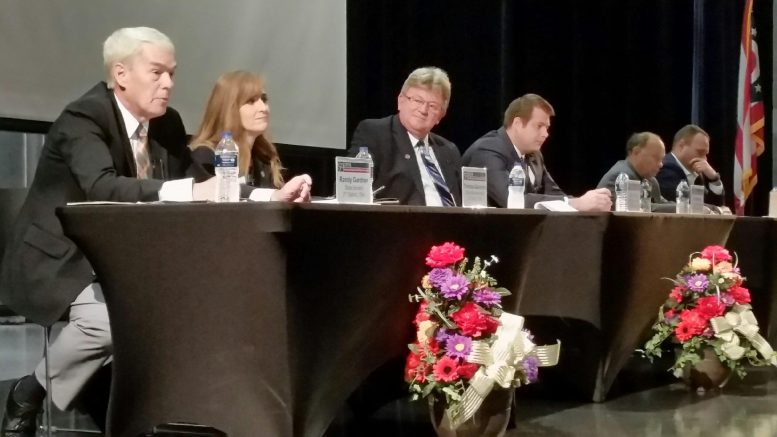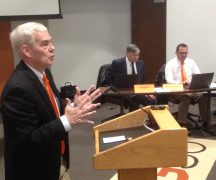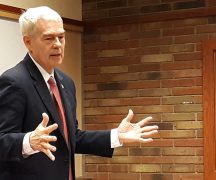By JAN LARSON McLAUGHLIN
BG Independent News
When local officials had a chance to quiz their state legislators Wednesday, there were more questions than time for answers. Lawmakers were asked about some hot button issues like Lake Erie efforts, school testing, gas taxes, and the state’s growing rainy day fund.
Fielding the questions were State Senator Randy Gardner and State Rep. Theresa Gavarone, both R-Bowling Green, plus Ohio state representatives Jim Hoops, Derek Merrin, Mike Sheehy, and Michigan state representative Jason Sheppard.
Asking the questions were members of the Toledo Metropolitan Area Council of Governments, during the organization’s summer caucuses with state lawmakers at Penta Career Center. Acting as moderator was Wood County Commissioner Doris Herringshaw, current chairperson of TMACOG.
Tim Brown, executive director of TMACOG, said the agency has a 50-year history of going beyond politics to solve problems.
“We lay the politics aside, put the partisanship at the door, and talk,” Brown said.
The first question was about state efforts to stop harmful algal blooms in Lake Erie. While actions already taken have been appreciated, the local officials wanted to know “What’s next?”
Gardner acknowledged that the work on Lake Erie is far from over.
“There is no misunderstanding that we’ve done all that we can do,” he said. “We can find a way to do more and do better. We must.”
Gardner said he hasn’t given up on a proposal to create a clean water bond issue. “Quite frankly, we haven’t received strong support from the governor to go forward,” he said. But Gardner is hopeful the bond issue can be revisited next year.
Sheehy said environmental groups are “tired of failure” as the state struggles to find solutions. “We’ve all been saying this a long time. More needs to be done.”
School officials asked about state testing requirements for students.
Gavarone said testing requirements have been reduced, but more needs to be done to get timely feedback to teachers and parents, so they know how to help students.
Gardner added that any testing requirements that aren’t federally mandated need to be reviewed. “They should be questioned and scrutinized as to their value,” he said.
The legislators were asked about the state’s role in helping with workforce development. While Merrin said it isn’t the state legislature’s job to help create workforces, Gavarone and Gardner both offered other perspectives.
Gavarone said students should be exposed to construction trades early on. “Kids need to be aware of the multitude of paths available to them after graduation,” she said.
Gardner agreed that four-year colleges are just one option for Ohio’s youth.
“I’m for an all-of-the-above education policy,” he said, noting the quality apprenticeship and training programs in the region.
However, Gardner also said that four-year degrees still offer students the best long-run success. He suggested that the audience Google to find unemployment rates based on higher education.
“You will still see the unemployment rate go down and the wages go up,” with higher degrees, he said. “We owe our children to give them the best opportunities.”
Local officials also wanted to know when state leaders are going to share in some of the wealth of the state’s growing rainy day fund. Gardner said he considers local government to be an extension of state government.
“We should look at what we can share back with our local government partners,” Gardner said.
State cuts were made to Local Government Funds when times were tough at the state level, and the rainy day fund was dry – but that’s no longer the case, he said.
Local officials talked about road infrastructure challenges, and asked state lawmakers if they would support an increase in the state gas tax.
Merrin opposed an increase, saying that rather than taking more money from taxpayers, the existing funding just needs to be allocated properly. Hoops reminded that without the last gas tax, the improvements to U.S. 24 never would have occurred.
“I understand the frustration of your question,” Gardner said. But he added that additional transportation funding has been shared with Northwest Ohio from turnpike revenues.
Sheppard noted that Ohio spends twice as much on its roads as Michigan. So in spite of concerns, the legislature there recently voted to raise the gas tax.
“We had to do something, other than sit back and watch things crumble,” Sheppard said. “Citizens want things fixed and done.”
The Ohio legislators were also asked about putting more money into tourism in the state.
Gardner complimented Michigan for its tourism strategy. “Everybody knows Michigan’s slogan, ‘Pure Michigan,'” he said.
“This is one area where the dollars invested come back in a variety of ways,” Gardner said. “Yes we ought to do more.”
Though studies show that investments in tourism result in raising more than four times as much in revenue, Ohio continues to spend less than many neighboring states, he said.
“Yes, we can and should do more,” Gardner said.
Sheppard said Michigan’s tourism spending is always the “first thing on the chopping block” when budgets get tight. However, he and other legislators have been able to convince the state to continue supporting Michigan’s push for tourist dollars.
“Pull your heads out of your behinds and realize tourism works,” he said he tells fellow Michigan lawmakers.





